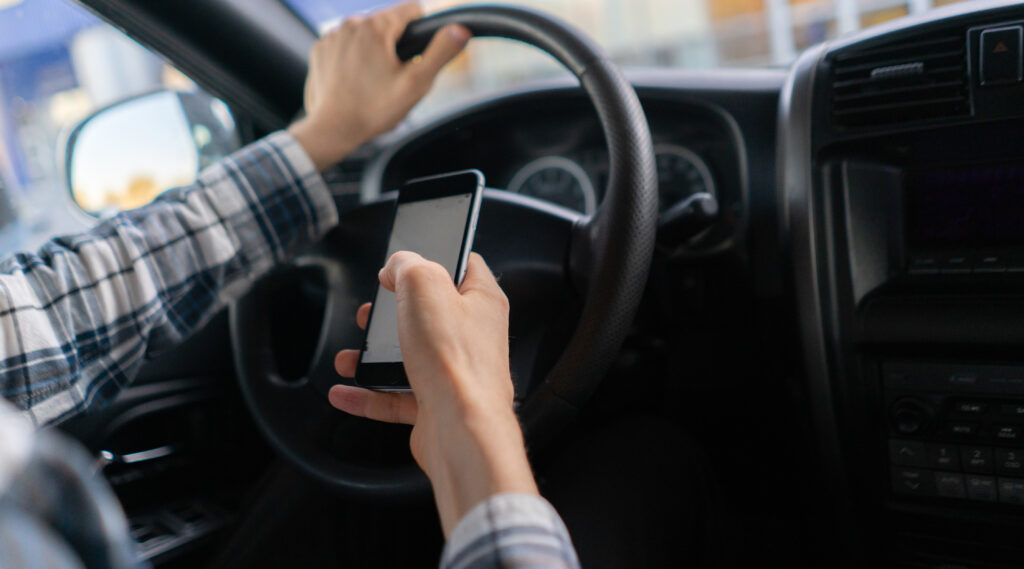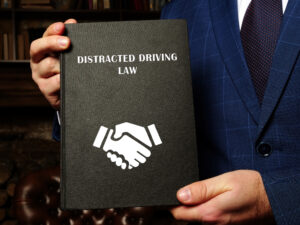
The CDC reports that nine people die every day in America because of distracted driving. Thousands of people suffer an injury every year because drivers take their eyes off the road. Even glancing for a second or two at your cell phone while driving can be immensely dangerous. Anything that takes a driver’s attention on the road for even a second can be distracting.
If you were recently injured in a car or pedestrian accident caused by a distracted driver, you don’t have to suffer alone. An experienced Bakersfield car accident attorney may ensure you receive fair compensation for your losses. You can, for example, receive compensation for your past and future medical bills, lost current and future income, pain and suffering, and a damaged or totaled vehicle. Speak to an experienced car accident attorney today to learn if your case may qualify for a settlement.
Distracted Driving Statistics
The following statistics about distracted driving show how hazardous the practice is. If a distracted driver has hurt you or a loved one, talk to a licensed car accident attorney in your city today.
- 3,000 people die in distracted driving crashes annually. This accounts for approximately nine percent of all auto accidents in the US annually.
- Distracted driving claimed the lives of 3,142 people. This number included 396 deaths when a cell phone was in use during the accident.
- 2,880 deadly accidents that involved distracted driving. Unfortunately, some crashes cause multiple deaths.
- Eight percent of deadly auto crashes are from distracted driving. Distracted driving is estimated to cause eight percent of fatal auto accidents. By comparison, about 30 percent of fatal auto accidents that year were due to impaired driving.
- 587 pedestrians died in distracted driving crashes. Distracted driving accidents claim the lives of hundreds of pedestrians and cyclists every year.
What Is Distracted Driving?
The NHTSA states that distracted driving is any activity that takes a driver’s attention from the road. The agency also notes there are three basic types of driving distractions:
- Visual: The driver isn’t paying attention to where they are going.
- Manual: The driver takes their hand or hands from the wheel.
- Cognitive: The driver’s mind is drifting from driving tasks.
These are the most common types of distracted driving that often trigger serious and fatal auto accidents:
Cell Phone Use

Using a cell phone while driving is one of the most hazardous things we can do in the driver’s seat. Whether talking, texting, checking navigation, or scrolling through social media, these activities take your attention from driving. It takes about five seconds of a driver’s attention to a cell phone to send a quick text, but approximately 77 percent of young drivers say they can drive safely when driving (they can’t!). Distracted driving with cell phones is the number one cause of teen driver injuries and death.
But cell phone distractions aren’t just for the young on American roads. This isn’t true. A recent study revealed that 81 percent of Gen X and Millenial drivers admit to using a cell phone while driving.
Eating And Drinking
Eating and drinking while driving are also dangerous, especially if you are eating something messy. When you start to drive, put away all food and drink. Even unscrewing a soda bottle lid can distract a driver enough from the road to cause a serious crash.
Fatigued Driving
Many people think that drunk driving is the most dangerous driving activity. However, fatigued driving can be just as dangerous and distracting. The AAA Foundation for Traffic Safety states that 41 percent of drivers admit to falling asleep while driving. Meanwhile, the NHTSA reports that fatigued driving in the US leads to 100,000 accidents per year, with 40,000 serious injuries and 1,550 fatalities.
Anyone driving for several hours on the highway should pull over and rest whenever they feel tired. Even if you don’t stop for the night, just pulling over at a rest stop and walking around the car can be enough to rejuvenate you.
Daydreaming
Driving can be a good time to be yourself and collect your thoughts about the day ahead. With enough experience, driving can become nearly automatic, and we don’t usually need to think about everything we do when the car is in motion.
However, it’s easy for driving to become so automatic that we begin to daydream and not pay attention to our surroundings. Doing so can cause serious accidents. As reported, most rear-end accidents occur due to driver distraction, which often involves daydreaming.
Roadside Distractions
There are always plenty of distractions outside the car window. For example, many billboards are now animated and tempting to look at. However, at 55 miles per hour, a vehicle can travel about 150 feet in just four seconds. So, while the driver focuses on the pretty mountains or an interesting billboard, a serious accident can happen in seconds.
Talking With Passengers
Many drivers have passengers in their vehicles and talk while driving. Some conversations while driving can be useful, such as helping with traffic or directions. But other conversations can be a major distraction. For example, a driver who argues with their spouse in the passenger seat is probably not paying sufficient attention to the road. Drivers and passengers should save serious conversations for later when the vehicle isn’t in motion, or they are at home.
Reaching For Objects
 How many times have you placed something on the car seat next to you that fell off while the car was moving? Remember to leave that item on the floor until you can pick it up safely. Reaching for a falling object when the vehicle is in motion may take only three or four seconds, but that’s all needed for a disastrous accident.
How many times have you placed something on the car seat next to you that fell off while the car was moving? Remember to leave that item on the floor until you can pick it up safely. Reaching for a falling object when the vehicle is in motion may take only three or four seconds, but that’s all needed for a disastrous accident.
Ensure that all items in the vehicle are safely stowed and won’t distract you while the vehicle is moving.
Adjusting Vehicle Systems
Your hands should always be on the steering wheel when driving. There is no time to change the climate control, GPS, seats, or mirrors while driving. Pre-adjust these systems before hitting the road to ensure your attention remains focused on driving.
Dealing With Pets Or Children
Before the vehicle moves, ensure your pets or small children are safely secured. If they need attention, pull off the road to deal with them safely instead of reaching behind you while driving.
Driver Distraction Laws By State
Most states have laws banning cell phone use while driving. Various classes of drivers, such as truckers, bus drivers, young drivers, and federal employees, often face restrictions on cell phone use. However, no state has completely banned cell phone use for every driver.
Reportedly, 48 states have texting-and-driving bans for all drivers. Forty-four states have primary enforcement, and four with secondary enforcement. Primary enforcement means the police can pull a driver over if they suspect they are engaged in distracted driving. Secondary enforcement can issue a distracted driving citation if they pull the driver over for another infraction.
Legal Options For Distracted Driving After A Car Accident
If another driver hits and injures you, you can sue for damages, including if they were distracted while driving. However, you and your car accident lawyer must prove that the other party was distracted. You also must offer evidence of your injuries and other damages.
Proving the other driver was at fault in a distracted driving accident involves showing that they were negligent. You must prove four factors in a personal injury claim for distracted driving or other misdeeds or negligence:
- Duty of care: Every driver on public roads owes the public a duty of care to drive safely and obey traffic laws.
- Breach of duty: The other driver breached their duty of care by driving distracted. For example, if another driver was checking Facebook and rear-ended you at a stop sign, they breached their duty of care.
- Causation: The distracted driver’s negligence caused the crash and your injuries.
- Damages: You have damages from the accident, such as medical bills, lost income, and pain and suffering.
If you think a distracted driver caused your accident injuries, you will usually file a personal injury claim on their or your insurance, depending on the situation. If your attorney cannot negotiate a fair settlement, filing a personal injury lawsuit may be necessary.
Filing a personal injury claim usually involves working with the other driver’s insurance company to pay for your damages. The insurance company can lowball you, deny the claim outright, or offer a fair settlement for your losses. You can accept the offer or continue negotiating for more money. A car accident attorney is valuable when negotiating a personal injury settlement.
You can file a personal injury lawsuit if the insurance company does not offer enough money in a settlement. This means your attorney will take the case to a judge or jury and argue for a verdict in your favor.
Whether to settle or sue is a complex decision. Much depends on the strength of the evidence that the other driver was distracted. Also critical is your degree of injury and the amount of financial damages.
How To Prove The Other Driver Was Distracted

Whether the other driver was distracted or speeding, proving they were at fault for the crash is critical to your case. Several common pieces of evidence can be important for proving distracted driving. Your attorney will be instrumental in collecting this evidence, but you can also be a key part of the process.
First, assume that you believe the other driver was texting when they hit your vehicle. The burden of proof in a personal injury claim is a preponderance of the evidence, which means that the defendant was more likely than not to have caused the crash. Some evidence that may prove that the driver was texting or otherwise distracted is:
- Cell phone records: Your auto accident attorney can subpoena the driver’s cell phone records to determine what they did when they crashed into you. Getting a copy of cell phone records will show if their phone was in use when the accident occurred. Your attorney will know how to file the subpoena correctly so they can access these important records.
- Video surveillance footage: If video footage of the accident existed, it could be crucial to proving distracted driving. For example, a video camera outside a gas station can show that the at-fault driver was looking at their cell phone when they hit you. Your attorney can help find any existing video footage of the accident.
- Police report: The police will usually respond to any serious accident. The police report may contain relevant information that aids your case. The responding officer, for example, may not suspect distracted driving or other negligent behavior involved in the accident.
- Eyewitness testimony: Statements from witnesses can be vital to proving distracted driving. After the accident, take the contact information and statements from eyewitnesses. Provide this information to your attorney.
- Accident reconstruction: Your attorney may hire accident reconstructionists to show the court or insurance company how the crash happened. The accident reconstruction report may prove that the driver who ran into you was texting or not paying attention.
Your attorney is a helpful resource for proving that a distracted driver caused your accident and resulting injuries. A law firm can access considerable resources that convincingly prove that driver distraction caused the accident. They can gather evidence such as phone records, witness statements, and professional testimony to strengthen your case and maximize your chances of receiving fair compensation.
Contact An Experienced Car Accident Attorney Today

Mickey Fine, Car Accident Lawyer
Have you or a loved one suffered injuries due to a distracted driver? Distracted driving is a serious problem on our roads. If a negligent driver has caused you to harm, you may be entitled to compensation for medical expenses, pain and suffering, property damage, and emotional distress. Contact a skilled car accident lawyer today to assess the strength of your case. With no legal fees, there’s no risk in seeking justice for your injuries unless you win compensation.
